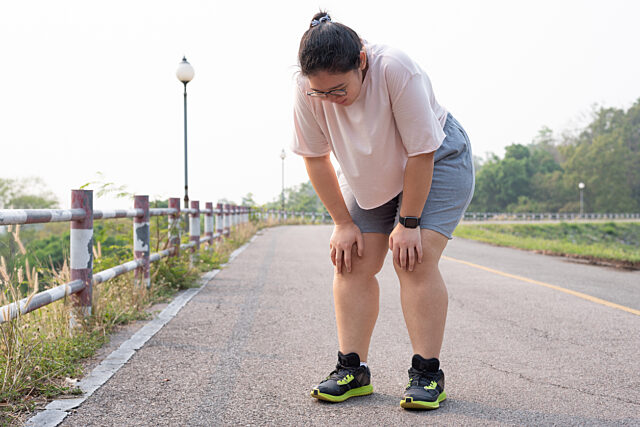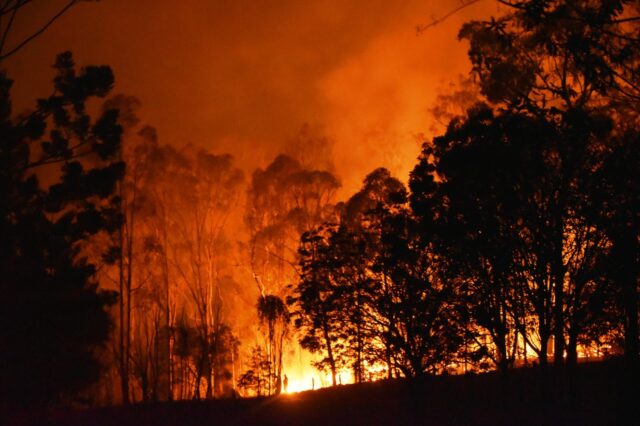Australian Asthma Handbook
The National Guidelines for Health Professionals
Cite
Warn parents and carers to ensure that children are not exposed to smoke from smoking (tobacco or other substances) or vapour from electronic cigarettes in the home or daily environment.
Recommendation type: Consensus recommendation
In children with asthma, exposure to environmental tobacco smoke doubles the risk of hospitalisation for asthma and significantly increases the risk of exacerbations requiring emergency department visits or urgent health care, wheezing, and poor lung function.[Wang 2015]
Very little is known about the effects of environmental vape emissions on asthma and lung health. Common flavouring agents in vapes are chemically similar to known airway irritants and sensitisers that have been reported to cause occupational asthma.[Clapp 2017]
Use of e-cigarettes results in an acute reduction in lung function in people with asthma, and a greater acute increase in airway inflammation than in people without asthma.[Kotoulas 2020] Vaping is associated with chronic lung disease and acute lung injury.[Casey 2020]
Casey AM, Muise ED, Crotty Alexander LE. Vaping and e-cigarette use. Mysterious lung manifestations and an epidemic. Curr Opin Immunol 2020; 66: 143-150.
Clapp PW, Jaspers I. Electronic cigarettes: Their constituents and potential links to asthma. Curr Allergy Asthma Rep 2017; 17: 79.
Kotoulas SC, Pataka A, Domvri K, et al. Acute effects of e-cigarette vaping on pulmonary function and airway inflammation in healthy individuals and in patients with asthma. Respirology 2020; 25: 1037-1045.
Wang Z, May SM, Charoenlap S, et al. Effects of secondhand smoke exposure on asthma morbidity and health care utilization in children: a systematic review and meta-analysis. Ann Allergy Asthma Immunol 2015; 115: 396-401.
RACGP’s guidelines on smoking cessation
Information on association between smoke exposure and risk of developing asthma
Recommendation type: Consensus recommendation
Observational studies suggest that exposure to outdoor pollutants (ozone, nitrogen dioxide, sulphur dioxide, or particulate matter) trigger asthma symptoms and exacerbations in children, including severe exacerbations requiring hospital admission.[Tiotiu 2020]
Children are also at increased risk of the harmful effects of exposure to bushfire smoke, compared with adults, due to smaller airways, higher metabolic rate and ongoing development.[McDonald 2023] During bushfire smoke exposure children younger than 4 years may have a higher risk of severe asthma exacerbations and other respiratory symptoms than older children.[McDonald 2023]
McDonald VM, Archbold G, Beyene T, et al. Asthma and landscape fire smoke: A Thoracic Society of Australia and New Zealand position statement. Respirology 2023; 28: 1023-1035.
Tiotiu AI, Novakova P, Nedeva D, et al. Impact of air pollution on asthma outcomes. Int J Environ Res Public Health 2020; 17: 6212.
Environmental Protection Authority Victoria AirWatch
Environmental Protection Authority South Australia Air quality monitoring
Environmental Protection Authority Tasmania Real-time Air Quality Data for Tasmania
Environmental Protection Authority Northern Territory Air quality
Australian Capital Territory Air quality and pollen
Department of Water and Environmental Regulation Western Australia Air quality index
Queensland Department of the Environment, Tourism, Science and Innovation Live air data
Information on association between outdoor pollution and risk of developing asthma
Advise parents and carers:
Recommendation type: Consensus recommendation
Indoor exposure to nitrogen dioxide (e.g. due to gas stoves or heaters in homes or schools) increases the risk of asthma symptoms in preschool aged children[Hansel 2008, Kattan 2007] and may reduce lung function.[Gillespie-Bennett 2011]
In school-aged children with asthma, indoor NO2 concentrations from use of gas stoves has been reported to correlate positively with nighttime inhaler use.[Paulin 2017] Even relatively low exposure to indoor NO2 has been shown to be associated with respiratory symptoms among children with asthma.[Belanger 2006]
In school-aged children with asthma, woodfire smoke has been shown to reduce lung function and increase airway inflammation.[Allen 2008]
Allen RW, Mar T, Koenig J, et al. Changes in lung function and airway inflammation among asthmatic children residing in a woodsmoke-impacted urban area. Inhal Toxicol 2008; 20: 423-433.
Belanger K, Gent JF, Triche EW, et al. Association of indoor nitrogen dioxide exposure with respiratory symptoms in children with asthma. Am J Respir Crit Care Med 2006; 173: 297–303.
Gillespie-Bennett J, Pierse N, Wickens K, et al. The respiratory health effects of nitrogen dioxide in children with asthma. Eur Respir J Supplement 2011; 38: 303-9.
Hansel NN, Breysse PN, McCormack MC, et al. A longitudinal study of indoor nitrogen dioxide levels and respiratory symptoms in inner-city children with asthma. Environ Health Perspect 2008; 116: 1428–1432.
Kattan M, Gergen PJ, Eggleston P, et al. Health effects of indoor nitrogen dioxide and passive smoking on urban asthmatic children. J Allergy Clin Immunol 2007; 120: 618-24.
Paulin LM, Williams D'L, Peng R, et al. 24-h Nitrogen dioxide concentration is associated with cooking behaviors and an increase in rescue medication use in children with asthma. Environ Res 2017; 159: 118-123.
Consider allergen avoidance only when the child has proven sensitivity to the allergen and the allergen is a clinically significant asthma trigger.
Suggest only strategies that are likely to be effective and feasible to adopt.
Do not recommend onerous or expensive allergen avoidance strategies that have not been shown to improve asthma outcomes, but advise parents/carers about options and whether they are supported by evidence.
Recommendation type: Adapted from GINA
Routine allergen avoidance is not recommended for people with asthma as a strategy reducing symptoms or exacerbations, because potential effectiveness depends on the allergen and its clinical significance for the individual’s asthma. Allergen avoidance strategies are often complicated and expensive.[GINA 2025] Most strategies are not supported by evidence for clinical benefits, and it is not possible to identify which patients will benefit.[GINA 2025]
For patients living in mouldy houses, building repairs to reduce dampness in homes (e.g. leak repair, improvement of ventilation, removal of water-damaged materials) has not been shown to reduce asthma symptoms in children.[Sauni 2015]
There is limited evidence to support the use of cockroach baits in the homes of patients allergic to cockroaches,[GINA 2025, NAEPP 2020] and for integrated pest management systems in the homes of those allergic to pest rodents.[GINA 2025]
For other allergen reduction strategies, there is limited evidence that they reduce allergen levels, but do not improve asthma symptom control or reduce exacerbations.[GINA 2025]
For patients allergic to pets, clinical trial evidence does not support removal of pets, high-efficiency particulate air (HEPA) filter air cleaners, replacement of carpet with hard flooring, or use of vacuum cleaners with HEPA filters and double-thickness bags.[GINA 2025]
Overall, strategies for reducing dust mite exposure have not been shown to improve asthma outcomes in adults or children.[Gøtzsche 2008] For patients with dust mite allergy, the use of impermeable mattress and pillow covers as a single intervention, or use of acaricides, are ineffective in improving asthma symptom control.[NAEPP 2020] Some randomised controlled trials of multicomponent interventions that included the use of HEPA vacuum cleaners have reported improvements in asthma-related quality of life or asthma symptoms in children.[NAEPP 2020]
Multicomponent trigger avoidance strategies (which may include allergen avoidance in the home) improve overall quality of life and reduce school absenteeism due to asthma in children and adolescents with asthma.[Crocker 2011] Most interventions included home visits by a trained health worker, an assessment of the child’s environment and education, with or without remediation.[Crocker 2011]
Some outdoor allergens, such as pollens and moulds, are impossible to avoid completely. [GINA 2025]
Crocker DD, Kinyota S, Dumitru GG, et al. Effectiveness of home-based, multi-trigger, multicomponent interventions with an environmental focus for reducing asthma morbidity: a community guide systematic review. Am J Prev Med 2011; 41: S5-32.
Global Initiative for Asthma (GINA). Global Strategy for Asthma Management and Prevention, 2025. Available from: www.ginasthma.org
Gøtzsche PC, Johansen HK. House dust mite control measures for asthma: systematic review. Allergy 2008; 63: 646-659.
National Asthma Education and Prevention Program Coordinating Committee Expert Panel Working Group. 2020 focused updates to the asthma management guidelines. US National Heart, Lung and Blood Institute, Department of Health and Human Services: 2020.
Sauni R, Verbeek JH, Uitti J, et al. Remediating buildings damaged by dampness and mould for preventing or reducing respiratory tract symptoms, infections and asthma. Cochrane Database Syst Rev 2015; 2: CD007897.
More information on asthma triggers
Follow Australian Technical Advisory Group on Immunisation recommendations on RSV, influenza, pneumococcal, pertussis and COVID-19 vaccinations.
Provide patients with clinical evidence on risks and benefits to make informed decisions about recommended vaccinations that are not free of charge through the National Immunisation Program.
Recommendation type: Consensus recommendation
The recommendation for vaccination of people with asthma against respiratory diseases is based on both general benefits and known additional risks of respiratory infections for people with asthma. For most infections there is a lack of clinical trial evidence directly demonstrating that vaccination prevents asthma symptoms or exacerbations.
In children with asthma, infections with respiratory viruses, most commonly rhinovirus, contribute to most acute exacerbations.[Jartti 2017] However, other infectious diseases that are vaccinable may also contribute to exacerbations.[Jartti 2017]
Influenza vaccination: Large retrospective cohort studies have reported conflicting findings on whether influenza vaccination protects against asthma exacerbations in children.[Kramarz 2001, Christy 2004] Some RCTs and some observational studies have reported reductions in acute asthma exacerbations, wheezing episodes and hospitalisations among children vaccinated against influenza, compared with unvaccinated children.[Vasileiou 2017] Influenza vaccines do not trigger asthma exacerbations.[Cates 2013]
Pneumococcal vaccination: Asthmamay be a risk factor for invasive pneumococcal disease. Children aged ≤17 years with asthma have a higher risk of invasive pneumococcal disease than adults with asthma.[Li 2020] Studies assessing the effects of pneumococcal vaccination on asthma exacerbations in children have reported inconsistent findings.[Sheikh 2002]
RSV: Severe RSV with a marked inflammatory response can trigger asthma exacerbations in children.[Jartti 2017] However, RSV vaccination has not been shown to prevent asthma exacerbations in children with asthma.
Australian Government Department of Health and Aged Care. Australian immunisation handbook (website) [accessed January 2025]
Cates CJ, Rowe BH. Vaccines for preventing influenza in people with asthma. Cochrane Database Syst Rev 2013; 2: CD000364
Christy C, Aligne CA, Auinger P, et al. Effectiveness of influenza vaccine for the prevention of asthma exacerbations. Arch Dis Child 2004; 89: 734-735.
Jartti T, Gern JE. Role of viral infections in the development and exacerbation of asthma in children. J Allergy Clin Immunol 2017;140(4):895-906.
Kramarz P, Destefano F, Gargiullo PM, et al. Does influenza vaccination prevent asthma exacerbations in children? J Pediatr 2001; 138: 306-310.
Li L, Cheng Y, Tu X, et al. Association between asthma and invasive pneumococcal disease risk: a systematic review and meta-analysis. Allergy Asthma Clin Immunol 2020; 16: 94.
Sheikh A, Alves B, Dhami S. Pneumococcal vaccine for asthma. Cochrane Database Syst Rev 2002; 1: CD002165.
Information on RSV as a risk factor for developing asthma
Refer patients with suspected or confirmed food allergy to an allergist or clinical immunologist.
Ensure the patient has an anaphylaxis action plan and adrenaline auto-injector.
Recommendation type: Consensus
Foods are rarely a trigger for asthma.[Burks 2012]
However, coexisting asthma and food allergy is a strong risk factor for severe food-induced anaphylaxis, including life-threatening reactions.[Burks 2012]
Airway inflammation measured by FeNO may persist in children with peanut allergy after apparent remission of asthma, and might therefore contribute to respiratory symptoms after food allergen exposure.[Burks 2012]
Burks AW, Tang M, Sicherer S, et al. ICON: food allergy. J Allergy Clin Immunol 2012; 129: 906-920.
ASCIA’s action plans for anaphylaxis

Adjunctive management
Advising parents about exercise and diet.

Clinical topics
Information on exercise-induced asthma symptoms in children and adults and asthma management for elite athletes.

Clinical topics
Information on managing common asthma triggers including exercise, respiratory infections, airborne allergens, and…